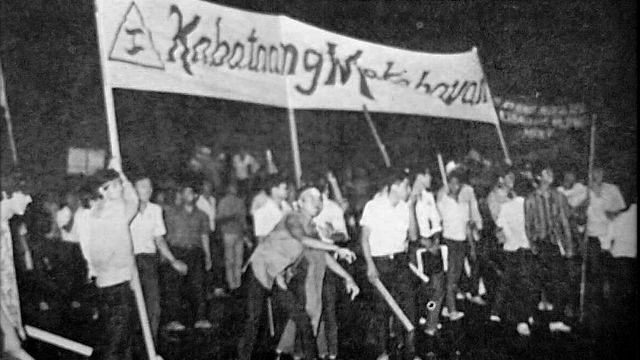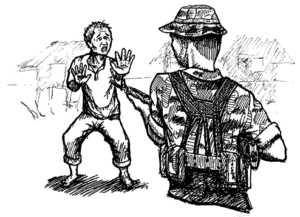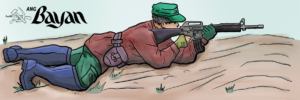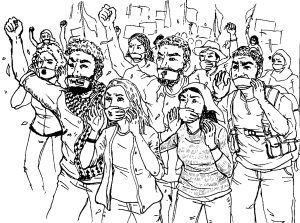Celebrate the FQS of 1970, honor and emulate the heroic activist youth

Beloved fellow activists,
Once more I wish to express warmest greetings of solidarity to the First Quarter Storm Movement and my congratulations for the successful preparations directed by the FQS@50 Coordinating Committee for the celebration of the 50th anniversary of the FQS of 1970 from January to March this year.
I am happy and gratified to have participated in the preparations from the beginning in 2018 by presenting at the maiden forum of the Forum Series on the FQS of 1970 an overview of this historic event as framework for succeeding forums until 2020. I discussed the chain of events in the 1960s that led to the FQS of 1970, its distinctly great historic significance, its far reaching consequences and continuing relevance.
By way of further contributing to the celebration of FQS, I have also proposed to the International Network for Philippine Studies the republication of the book, First Quarter Storm of 1970. This can be read as a partner to the eye witness and insightful reports in Jose Lacaba’s book, Days of Disquiet and Nights of Rage.
It carries the evaluative articles of Amado Guerrero, Chairman of the Central Committee of the Communist Party of the Philippines and editor of Ang Bayan, on the series of mass protests by students, teachers, other professionals, workers and other urban poor who rose up and asserted the general line and popular strength of the national democratic movement and rocked the semicolonial and semifeudal ruling system from base to rafters.
The Significance of FQS of 1970
The FQS of 1970 broke out in the revolutionary spirit of continuing the unfinished Philippine revolution and confronted the three evil forces that oppressed and exploited the Filipino people: US imperialism, feudalism and bureaucrat capitalism then chiefly represented by the Marcos regime.
The gigantic mass protests in FQS of 1970 were unprecedented in scale and intensity, They were the culmination of the long series of smaller mass protests launched by the youth from 1961 onwards and carried out even more militantly and more widely since 1964 under the leadership of the comprehensive youth organization, Kabataang Makabayan.
Marcos had just won his reelection by spending a colossal amount of public money in the 1969 presidential elections and was widely denounced for the resultant soaring of the prices of basic commodities. Reacting to protest mass actions in December 1969, he threatened to declare martial by way of intimidating the opposition and the people.
But he would concur with the reformists, including the clerico-fascists who called themselves social-democrats, that charter change was necessary to prevent the social volcano from erupting. He had the ulterior motive of imposing a fascist dictatorship on the people by initially using transitory provisions of a new constitution.
On January 26, 1970 in front of Congress, 10,000 student demonstrators came from the Catholic schools under a reformist leadership. The bigger KM contingent, consisting of students and workers, joined them. Marcos made the mistake of ordering the attack on the demonstrators after a cardboard coffin was thrown at him by a small group headed by the radio broadcaster, Roger Arienda.
The police brutality inflicted casualties on the student demonstrators. But it served to ignite the series of mass protests, which ranged in size from 50,000 to 150,000, from January to March 1970 in the national capital region. These spread to other universities, colleges and high schools on a nationwide scale.
As a result of its previous work in arousing, organizing and mobilizing the youth in the sixties, the KM was able to spearhead the FQS of 1970 as it grew and developed. At the same time, the Movement for a Democratic Philippines (MDP) sought to build a broad united front to oppose the US-Marcos regime.
The FQS gave birth to so many youth activists and so many youth groups. The organizers and speakers of the main political organizations and cultural groups played a key role in arousing, organizing and mobilizing the youth. They generated thousands of young activists who advanced the national democratic movement in schools, urban communities, factories and farms.
The FQS became a cultural revolution, as Prop-ED teams, schools for national democracy and cultural groups of creative writers and artists proliferated and became active. Revolutionary literature flourished. The marches and rallies were always enlivened by artistic murals and performances.
Many of those who joined Kabataang Makabayan, the Samahan ng Demokratikong Kabataan and various cultural groups in the course of the FQS eventually became proletarian revolutionaries and joined the Communist Party of the Philippines. They were determined to carry out the people’s democratic revolution through people’s war in response to Marcos’ threat and preparations for fascist dictatorship.
By the time that Marcos suspended the writ of habeas corpus on August 21, 1971 and then proclaimed martial law on September 22, 1972, there was already a large corps of educated youth and workers determined to wage the people’s democratic revolution through protracted people’s war.
All the time that the Marcos fascist regime enjoyed the support of US imperialism, the conservative opposition was reduced to making legal protests and lobbying for the US to change its policy of supporting Marcos. The CPP led the people’s resistance by waging armed struggle in the countryside and carrying out workers’ strikes and lightning mass protests in urban areas.
The CPP was energized by activists from the FQS on a nationwide scale. They did revolutionary mass work among the workers, peasants, indigenous people, youth, women, professionals and other people in order to wage all forms of struggle, especially people’s war, against the fascist puppet regime.
Despite the grave risks of capture, torture, prolonged detention or death, the veterans of the FQS contributed greatly to the development of the armed revolutionary movement and the building of underground and aboveground organizations and networks for people’s resistance.
The aggravation of the chronic crisis of the ruling system by the Marcos regime and the rise of the armed revolutionary movement ultimately persuaded US imperialism to consider the regime as more of a liability than an asset and thus started to junk him from the time that Marcos made the mistake of having Benigno S, Aquino assassinated on August 21, 1983 and unwittingly igniting the gigantic mass protest actions from 1983 to his downfall on February 25, 1986.
The activists generated by the FQS of 1970 were in the forefront of the mass protest actions from 1983 onwards, which ranged in size from 50,000 to several hundreds of thousands. They constantly waged all forms of struggle against the Marcos regime until 1986 when two to three million people rose up on Edsa and the contingent of more than one thousand people directly encircled the presidential palace and compelled the fascist dictator to give up power and flee in a US helicopter.
Continuing Relevance of FQS of 1970
Since the fall of the Marcos fascist dictatorship, many veterans of the FQS have continued to contribute to the Filipino people’s struggle for national and social liberation in various capacities in the legal democratic movement or in the field of revolutionary armed struggle.
In the course of this protracted struggle, FQS veterans have paid for their achievements in serving the people by working hard, going against tremendous odds and making sacrifices in terms of martyrdom and deprivations.
They are leaving to the current generation and succeeding generations a great legacy that must be cherished as a source of inspiration and as a lasting relevant guide to patriotic and revolutionary activism.
To this day, the FQS of 1970 remains relevant to the continuing struggle for full national independence, democracy, social justice and all-round development against the persistent semicolonial and semifeudal conditions.
The FQS of 1970 is a fountain of knowledge and collective experience about the socio-economic and political conditions of Philippine society, the general line of people’s democratic revolution, the strategy and tactics of the revolutionary struggle and the mass line and slogans that can arouse, organize and mobilize the people.
We can learn from the FQS of 1970 how to prepare for gigantic mass protests, how to use indoor and outdoor rallies on campuses and communities, how to do propaganda and agitation, how to make artistic works to serve the mass actions and how to assemble at different points in a city and then march to the converging point.
It is our noble and urgent task to celebrate the First Quarter Storm of 1970 and to honor and emulate those who participated in this revolutionary storm by carrying out mobilizations, forums and other gatherings.
Today the best way to fulfill our task is to call on the broad masses of the people to rise up against the tyrannical, treasonous, murderous, corrupt and mendacious Duterte regime and realize the intensification of mass protests and other forms of struggle in order to hasten the end of this malignant regime.
We are confronted today by a regime which idolizes Marcos and which is quite similar to the Marcos fascist regime in being a puppet of US imperialism and chief representative of the local exploiting classes. It would be a sterile way of celebrating the FQS of 1970 if we do not pay attention to the need for mass protests against the Duterte regime.
It should be easier now to carry out mass mobilizations against the regime because the legal democratic forces are now far stronger than they were in 1970 and have become far more experienced in waging mass struggles.
The chronic crisis of the ruling system has been aggravated by extreme oppression and exploitation under the combined policies of neoliberalism and fascism. These conditions are exceedingly favorable for strengthening and advancing the national democratic movement through mass struggles.
In view of the gross crimes of the Duterte regime against the people, it is necessary and possible to realize a broad united front to arouse, organize and mobilize the people in their millions against the common enemy.
Rely mainly on the basic forces of workers and peasants, win over the middle forces of the urban petty bourgeoisie and the middle bourgeoisie and take advantage of the splits among the reactionaries in order to isolate and destroy the power of the enemy regime.
It is high time for the Filipino youth and people to rise up against a traitorous, terrorist and plundering regime that has terminated the GRP-NDFP peace negotiations in order to wage all-out war against the broad masses of the people and their revolutionary forces as well as the legal democratic forces.
It slanders the people’s democratic revolution as terrorism, labels activists as communist terrorists, extends the murderous methods of Oplan Tokhang to the brutal suppression of political opponents and critics and uses the slogan of anti-communism in order to militarize and make fascist the entire reactionary government and society.
Without a strong mass protest movement, the Duterte regime will continue to carry out its scheme of imposing fascist dictatorship on the people through charter change. In fact, the regime has continued to impose a state of national emergency on the people since September 4, 2016.
The Filipino youth and people of today must cry out as in the FQS of 1970: Makibaka, huwag matakot! Digmang Bayan ang sagot sa Martial Law!. Their organized forces are far stronger than ever before and the desire of the people for revolutionary change is far stronger than ever before.
The escalating oppression and exploitation under the policy regimes of neoliberalism and fascism are inflicting intolerable suffering and are driving the people of the Philippines and the world to wage all forms of resistance against imperialism and all reaction.
The crisis of the Philippine ruling system coincides with the crisis of the world capitalist system. Conditions are exceedingly favorable for the Filipino people to advance their struggle for national and social liberation and contribute significantly to the global resurgence of the anti-imperialist, democratic and socialist forces of the people.
Long live the revolutionary spirit of the First Quarter Storm of 1970! Down with imperialism, feudalism and bureaucrat capitalism! Long live the memory of martyrs and heroes of the FQS of 1970! Long live the FQS veterans and their successors! Makibaka, huwag matakot! Digmang bayan ang sagot sa martial law! Continue the national democratic movement! Long live the Filipino people! by Prof. Jose Maria Sison Founding Chairperson Kabataang Makabayan




